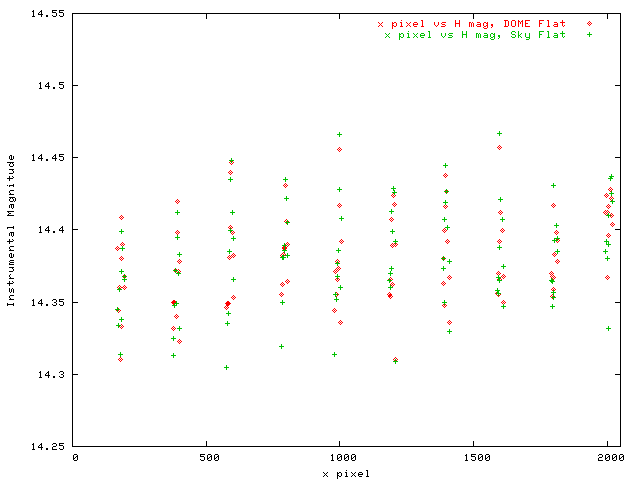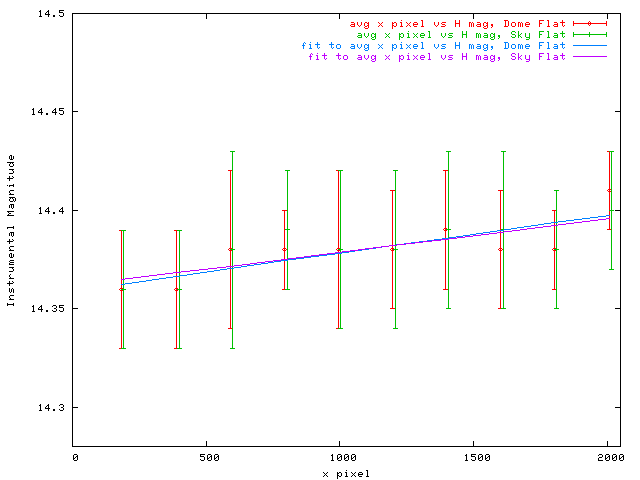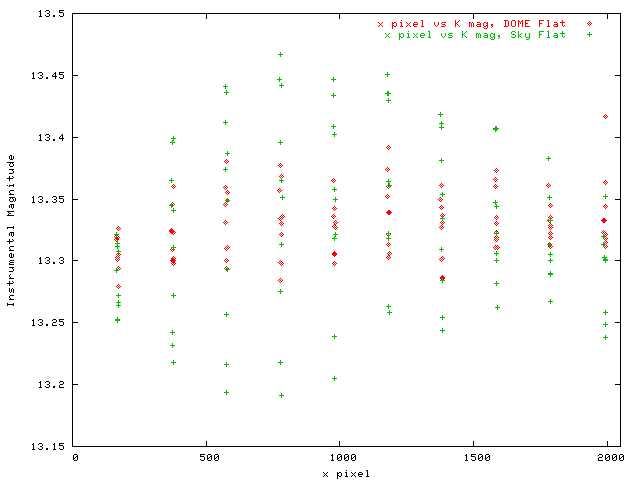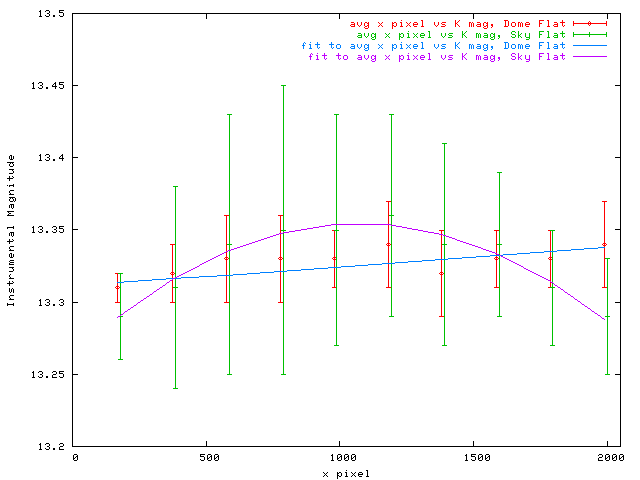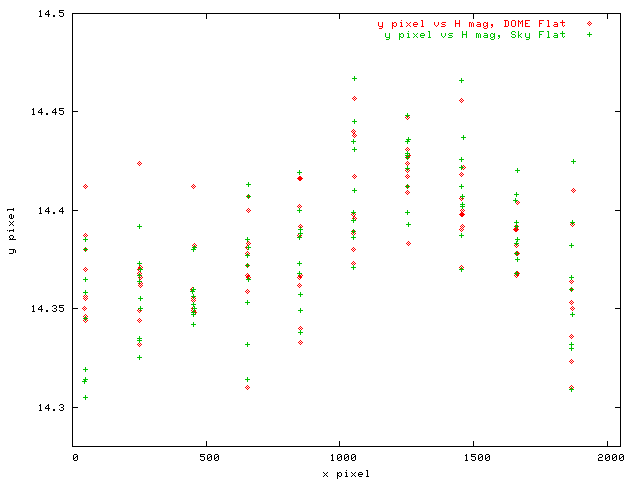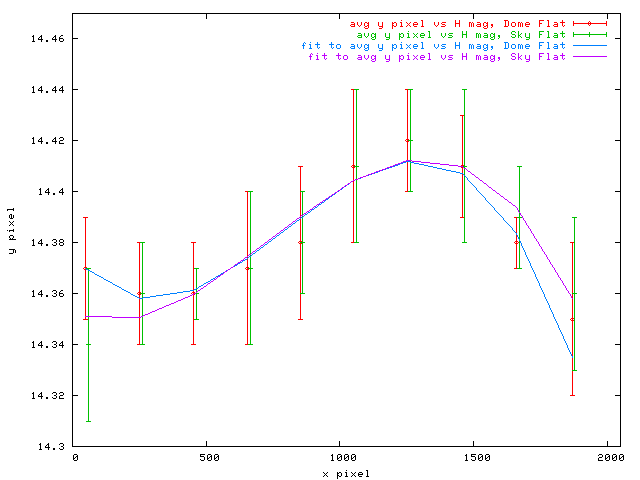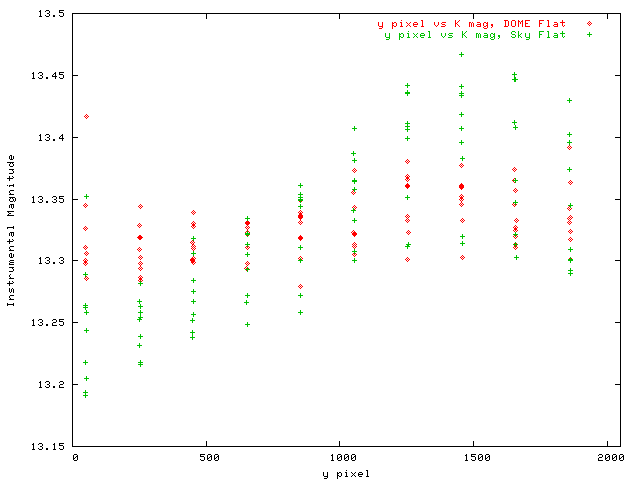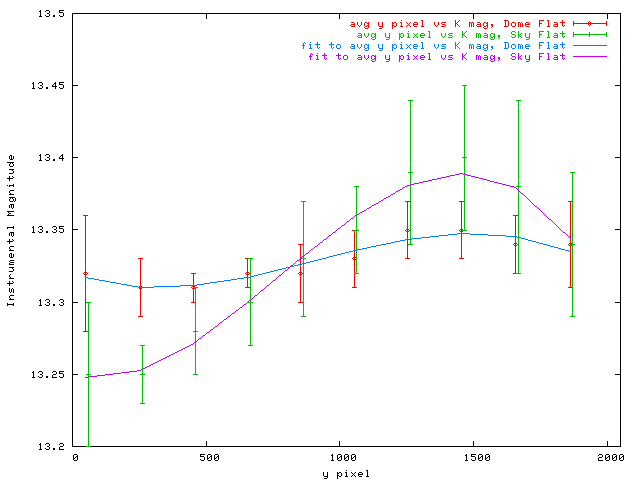ISPI Flat Fields
The following summarizes some issues regarding flat fields taken with ISPI using the Ks (aka KA) and H (aka (HA) filters (J band results are expected to be similar to those for H).
- These data were taken on 7 May 2004.
- The dome flats use the lower lamp box at 3.00 amps
- Exposure times are 3.3s, 5s, and 10s, for Ks, H, and J, respectively (15 frames lights on, 15 frames lights off)
- Sky flats below were made from 100 data frames at 3.3 seconds (with rejection of 30 high and 20 low frames from the stack to account for stars in the field).
- Ideally, flats should be constructed from series of "illumination on" minus "illumination off" images.
- In all cases, flats should be made from series of frames with the exact same data taking parameters (exposure time, coadd, repeats, Fowler reads, etc).
- Dome flats are recommended for Ks band data.
- Sky flats made from data (i.e. observations) will probably work equally well as dome flats for J and H.
- Twighlight flats will probably give similar results for H and J as for dome flats. At Ks, twighlight flats with varying illumination in which the "low" frames are subtracted from the "high" frames might give similar (or even better) results as for Ks dome flats.
- Twighlight flats at Ks made by subtracting dark frames will probably give similar results as for the sky flats described below and these will not be as good as dome flats.
The following plots show the results of placing a star at 100 evenly spaced positions over the ISPI 2048x2048 detector under photometric conditions.
- The individual frames were flat fielded with either a dome flat (as made in bullet 2 above) or a sky flat made by combining the data and subtracting a dark frame from the result.
- All flats were fixed for bad pixels and normalized by the mean counts in the image.
- Photometry is for a 6 pixel aperture with a 3 pixel sky annulus with inner radius of 6 pixels. No particular effort was made to optimize the aperture for varying image quality.
- Normal dome flats at Ks or dome/sky flats at H (and probably J) should have large scale uncertainties of about ~/< +/- 3% over the full field of view.
- The Ks flats might be affected by extra emission arising from the warm structure around M3 and a possible undersize of M3. The difference between "on" and "off" images appears to account for this putative extra emission. Sky flats would not normally account for such emission, and this is a possible explanation for the apparent better accuracy seen below for dome vs sky flats.
- It is not known what produces the residual large scale flat fielding errors seen in the plots.
- The following table contains text files of the photometry results which can be used to estimate second order corrections to H and Ks flats.
Figure 1a. Instrumental H Magnitude vs x pixel. Both sky and dome flats give similar results.
Figure 1b. Instrumental H Magnitude averaged over all y pixels for given x pixel. The linear fit suggests a full range of variation of +/- 2% due to large scale flat fielding uncertainty.
Figure 2a. Instrumental Ks Magnitude vs y pixel. The sky flat shows a much larger range of values than the dome flat. These represent systematic changes in the flat field, not variations due to photon statistics. Sky flats made by using illuminated frames and a dark frame should not be used unless the region of interest for objects and standards is restricted. The differences here are probably due to vingetting of the field at M3 combined with "off M3" background at Ks.
Figure 2b. Instrumental Ks magnitude averaged over all y pixels for a given x pixel. The fits show that the sky flat probably contains a component of emission comming in at the edges of the field around M3. The beam from M3 is "suppressed at the edges" by the flat.
Figure 3a. Same as Figure 1a, but for the y pixel vs H.
Figure 3b. Same as Figure 1b, but for y pixel vs H. The large scale variations are well fit by a 3rd order polynomial.
Figure 4a. Same as Figure 2a, but for the y pixel vs Ks.
Figure 4b. Same as Figure 2b, but for y pixel vs Ks.
Updated on May 28, 2021, 10:34 am
